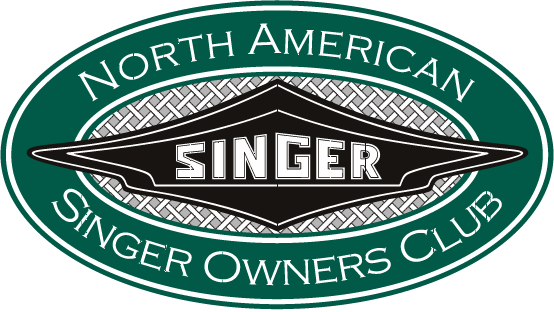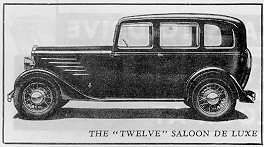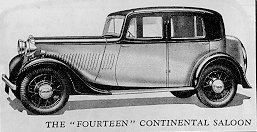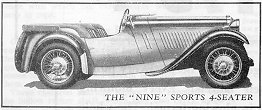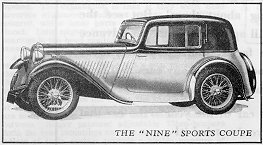Away back in the dim and distant past the Singer was the first real light car which was, in effect, a scaled down version of the big, comfortable touring cars of its era. Although the little 10 h-p vehicle was a good performer in competitions (Driven mostly by Lionel Martin), the Singer concern did not enter the sports car market seriously until 1933. Its is true that, from time to time sports versions of their chassis were produced, but the cars were not marketed as out and out sports cars, although many of them were modified as racing cars with success. The “Porlock” based on the “Junior” model, was the nearest approach to a sports vehicle, but its performance scarcely entitled it to the title of a true sports vehicle, despite the fact it had a potent little o.h.c power unit.
When the “Junior” grew up into the “Nine” it was the development of the 972c.c engine that led to the production of the original Singer Nine Sports, first marketed as a four seater only. This little car hit the jackpot right from the beginning and right away began to challenge the supremacy of the marque M.G by winning trial after trial.
The type had such great possibilities that a standard model was entered for the 1933 24-hour race at Le Mans by F.S.Barnes and A.H.Langley. This was actually the identical car that Langley had been using with success in competitions. Apart from a large petrol tank which took the place of the rear seat, it was practically unaltered. The little car justified its sponsors by finishing thirteenth in the general classification and being the first British car under 1000c.c ever to qualify for the Rudge Whitworth Biennial Cup. It covered 1900 kilometres in the twenty four hours, and ran throughout like clockwork.
From this car there sprang the series of Le Mans two seaters which were, in their day, amongst the most successful small sports cars ever produced in this country. Indirectly they caused the issue of the 939c.c “PB” MG, as the results of the trials and rallies of the period tended to feature the name of Singer in the prize lists with rather monotonous regularity. The cars also performed well in races, and more than once were the first British cars (and sometimes the only ones) to finish. A team of three (Langley, Bicknell and J.D.Barnes) won the L.C.C. 1935 Relay Race at Brooklands averaging 85.13 m.p.h-the team being managed by Stanley Barnes.
The tragedy of the make occurred in the 1935 T.T race, when three of the team cars crashed at the identical spot. This accident is looked into in a little more depth in the Racing “Nine” section. The damage to prestige was enormous, and the unfortunate accident undoubtedly had bearing on the Singer Companies decision to abandon sports car manufacture around 1937.
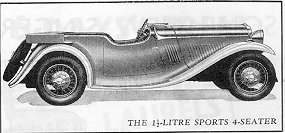
Side by side the “Nine” there also grew up a fine car. This was the 6 cylinder 1.5 Litre model (59*91mm, 1493c.c). Eventually this engine was put into the “Nine” chassis, and was capable of high speeds. In standard form (with triple S.U carburettors) it had a maximum speed of over 80 m.p.h., and in Autosports form the crab tracked versions could pass the century mark a fact that I have had experience of on the Silverstone racing circuit a few years ago when the needle tipped 95 m.p.h a number of times and still had a bit more in reserve, needless to say but not something I want to repeat in the near future. After the Singer concern had officially withdrawn from competition work the brother Barnes (Stanley and Donald) acquired several of the works cars, and in modified form raced them as Auto Sports Singers. They also competed in trials, speed events and rallies with great success, being a sort of “Scuderia Singer.” Other noted Singer exponents were Tommy Wise, Tommy Wisdom, Kay Petre, Sammy Davis, Leslie MacDonald, Godfrey Imhof, D Harris, J.S.Hindmarsh, the Savoye brothers of Paris, Tommy Sulman, Bob Spikins and George Murray-Frame to name just a few.
Towards the start of 1937 there was introduced a 1.5 Litre 4 cylinder car, which had the makings of a really super sporting vehicle. The 1496c.c (68*103mm) engine was also a chain driven o.h.c unit, as on all Singers. An unusual feature was the fitting of a vibration damper on the front of the crankshaft. the three bearing crankshaft was fully dynamically balanced. Twin S.U carburettors were used, whilst ignition was supplied by a Scintilla Vertex magneto. These cars were dubbed the B.37’s. Gear ratios were obviously chosen with trials in mind, and were 4.77, 6.96, 10.02 and 18.13 to 1. The Lockheed braking system included a hill holder, which was an invaluable item for stop and restart hill tests. The chassis was extremely robust and the car looked every inch a thoroughbred sports car. Despite the fact that its success was assured, Singers decided to cease the manufacture of the cars, and only about a dozen or so were delivered most of where for the works teams.
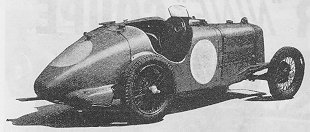
A supertuned version of the “Nine” was produced in 1936, and was known as the “Replica.” This was a genuine road racing car with a maximum of over 90m.p.h. Only four of these cars were built. The specifications conformed with the A.I.A.C.R regulations, and it was fitted with an attractive, light two seater body. The cars were rather affectionally dubbed the “Long Tail Singers.”
The most interesting part of the Singer sports cars was undoubtedly the power unit, probably on eof the most efficient light car engines devised of its type. The overhead valves were actuated by chain (duplex on 1.5 litre cars). The 972c.c unit had only two bearings right up to its demise. All Le Mans speed models had Scintilla Vertex magnetos and twin carburettors. Early examples had Zeniths, certain others had Solex, but the later were generally fitted with S.U’s.
The entire range of Singer sports cars had Lockheed hydraulic brakes, and the marque was always noted for excellent road holding and powerful anchoring. Suspension was by semi-elliptic springs fore and aft, controlled by friction type Hartford shock absorbers and all four speed synchromesh gearboxes.
